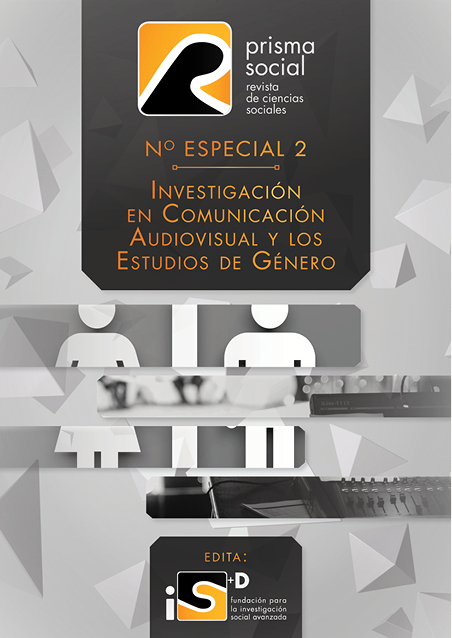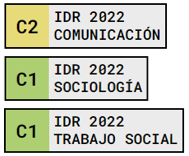(500) Days of Postfeminism: A Multidisciplinary Analysis of the Manic Pixie Dream Girl Stereotype in its Contexts
Palabras clave:
Postfeminismo, Manic Pixie Dream Girl, (500) Dias Juntos, Zooey Deschanel, cine indie, feminidadResumen
In 2007, after watching Elizabethtown (2005), film critic Nathan Rabin coined the term Manic Pixie Dream Girl in order to describe a nascent filmic female trope as “that bubbly, shallow cinematic creature that exists solely in the fevered imaginations of sensitive writer-directors to teach broodingly soulful young men to embrace life and its infinite mysteries and adventures” (2007). Since then, the concept acquired enormous widespread cultural currency, and the type of female characters responding to the stereotype multiplied, although not a single thorough scrutiny of its gender values has been undertaken from the Academia, perhaps due to the fact that independent (“indie”) productions – where most of these characters are found – provide their films with a certain patina of ideological credibility. However, with her performance of traditional cute (Ngai, 2012), girlish femininity, her vulnerability, her neoliberal sexual freedom, and, above all, her being-for-the-Other, the Manic Pixie Dream Girl perhaps constitutes the most powerful embodiment of postfeminist ideologies within independent cinema. In addition, her carpe diem philosophy and her “hipster” aesthetics speak directly to the idiosyncrasy of our time, characterized, as Slavoj Zizek (1994) explains, by a social injunction to “Enjoy!.”
Descargas
Citas
Alice, L. (1995). “What is Postfeminism? Or, Having it Both Ways.” In Feminism, Postmodernism, Postfeminism. New Zealand: Massey University.
Arendt, H. (1958). The Human Condition. Chicago: University of Chicago Press.
Attwood, F. (2013). “Through the Looking Glass: Sexual Agency and Subjectification Online.” En R. Gill y C. Scharff (Eds.), New Femininities: Postfeminism, Neoliberalism and Subjectivity (pp. 203-214). London: Palgrave McMillan.
Badiou, A. (2008) “One Divides Into Two.” Consultado 7 de julio de 2016 (http://www.lacan.com/divide.htm)
Bartky, S. (1990). Femininity and Domination: Studies in the Phenomenology of Oppression. New York and London: Routledge.
Bourdieu, P. (1993). The Field of Cultural Production. New York: Columbia University Press.
Bourdieu, P. (1994). Distinction: A Social Critique of the Judgment of Taste. Translated by Richard Nice. Cambridge: Harvard University Press.
Bowler, A. L. (2013). “Towards a New Sexual Conservatism in Postfeminist Romantic Comedy.” En J. Gwynne y N. Muller (Eds.), Postfeminism and Contemporary Hollywood Cinema (pp. 185-203). New York: Palgrave McMillan.
Bowman, D., Gillette, A., Hyden, S., Murray, N., Piece, L. and Rabin, N. (2008). "Wild Things: 16 Films Featuring Manic Pixie Dream Girls." A.V. Club. Consultado 3 de julio de 2016 (http://www.avclub.com/article/wild-things-16-films-featuring-manic-pixie-dream-g-2407)
Bronfen, E. (1992). Over Her Dead Body: Death, Femininity and the Aesthetic. Manchester: Manchester University Press.
Butler, J. (1985). “Embodied Identity in de Beauvoir’s The Second Sex.” Unpublished manuscript presented to American Philosophical Association, Pacific Division.
De Beauvoir, S. (1949). The Second Sex. London: Random House.
De Lauretis, T. (1984). Alice Doesn’t: Feminism, Semiotics, Cinema. Indiana: Indiana University Press.
Deleyto, C. (2009). The Secret Life of Romantic Comedy. Manchester: Manchester University Press.
Faludi, S. (1992). Backlash: The Undeclared War Against Women. London: Chatto and Windus.
Farrimond, K. (2013). “The Slut That Wasn’t: Virginity, (Post)Feminism and Representation in Easy A.” En J. Gwynne y N. Muller (Eds.), Postfeminism and Contemporary Hollywood Cinema (pp. 44-59). New York: Palgrave McMillan.
Fonarow, W. (2006). Empire of Dirt: The Aesthetics and Rituals of Indie British Music. Middleton: Wesleyan University Press.
Gamble, S. (ed.) (1998). The Routledge Companion to Feminism and Postfeminism. London: Routledge.
Genz, S. (2006). “Third Wave. The politics of post feminism.” Feminist Theory, 7.3: 333-353.
Genz, S. and Brabon, B. A. (2009). Postfeminism: Cultural Texts and Theories. Edinburgh: Edinburgh University Press.
Gill, R. (2007). “Postfeminist Media Culture: Elements of a Sensibility.” European Journal Of Cultural Studies, 10.2:147-166. Consultado 30 de agosto de 2016. DOI: 10.1177/1367549407075898
Gill, R. and Scharff, C. (2013). “Introduction.” En R. Gill y C. Scharff (Eds.), New Femininities: Postfeminism, Neoliberalism and Subjectivity (pp. 1-20). London: Palgrave McMillan.
Greco, P. (2012). “Zoe Kazan on Writing Ruby Sparks and Why You Should Never Call Her a ‘Manic Pixie Dream Girl’.” Vulture. Consultado 3 de julio de 2016 (http://www.vulture.com/2012/07/zoe-kazan-ruby-sparks-interview.html#)
Gwynne, J. and Muller, N. (2013). “Introduction.” En J. Gwynne y N. Muller (Eds.) Postfeminism and Contemporary Hollywood Cinema (pp. 1-12). New York: Palgrave McMillan.
Harris, D. (2000). Cute, Quaint, Hungry, and Romantic: The Aesthetics of Consumerism. New York: Basic.
Harvey, L. and Gill, R. (2013). “Spicing it Up: Sexual Entrepreneurs and the Sex Inspectors.” En R. Gill y C. Scharff (Eds.), New Femininities: Postfeminism, Neoliberalism and Subjectivity (pp. 52-6). London: Palgrave McMillan.
Hirschsorn, M. (2007). “Quirked Around.” Athlantic Monthly. Consultado 7 de julio de 2016 (http://www.theatlantic.com/magazine/archive/2007/09/quirked-around/306119/)
Horkheimer, M. and Adorno, T. W. (1944). Dialectic of Enlightment: Philosophical Fragments. Edited by Gunzelin Schmid Noerr, translated by Edmund Jeffcot. California: Stanford University Press.
Jameson, F. (1991). Postmodernism, or the Cultural Logic of Late Capitalism. Durham: Duke University Press.
Johnston, C. (1975). Notes on Women’s Cinema. London: Society for Education in Film and Television.
Kaklamanidou,B. (2013). Genre, Gender and the Effects of Neoliberalism. New York: Routledge.
King, G. (2005). American Independent Cinema. New York: IB Tauris.
King, G. (2009). Indiewood, USA: Where Hollywood Meets Independent Cinema. New York: IB Tauris.
Kinzey, J. (2012). The Sacred and the Profane: an Investigation on Hipsters. New York: Zero Books.
Lacan, Jacques (1982). “The Meaning of the Phallus.” En J. Mitchell y J. Rose (Eds.), Feminine Sexuality: Jacques Lacan and the Ecole Freudienne. New York: W. W. Norton.
Lacan, Jacques (1988). The Seminar of Jacques Lacan, Book II. Translated by Sylvana Tomaselli. Edited by J.A. Miller. Cambridge: Cambridge University Press.
MacDowell, J. (2010). “Notes on Quirky.” Movie: a journal of film criticism 1: 1-16. Consultado 7 de julio de 2016 (http://www2.warwick.ac.uk/fac/arts/film/movie/contents/notes_on_quirky.pdf)
MacDowell, J. (2013). “Quirky: Buzzword or Sensibility?” En G. King, C. Molloy y Y. Tzioumakis (Eds.), American Independent Cinema: Indie, Indiewood and Beyond (pp. 53-64). New York and London: Routledge.
Mailer, N. (1957). The White Negro. San Francisco: City Lights.
Matteson, P. (2013). “Uh Honey, That’s Not Your Line.” New York Times. Consultado 3 de julio de 2016 (http://www.nytimes.com/2013/07/28/fashion/uh-honey-thats-not-your-line.html?_r=0)
McDonald, T. J. (2009). “Homme-Com.” En S. Abbot y D. Jermyn (Eds.), Falling in Love Again: Romantic Comedy in Contemporary Cinema (pp. 146-159). London: IB Tauris.
McIntyre, M. P. (2014). “Isn’t She Adorkable! Cuteness as Political Neutralization in the Star Text of Zooey Deschanel.” Television and New Media 1: 1-17. Consultado 15 de julio de 2016 (http://tvn.sagepub.com/content/early/2014/02/27/1527476414524284)
McRobbie, A. (2007). “Postfeminism and Popular Culture: Bridget Jones and the New Gender Regime.” En D. Negra e Y. Tasker (Eds.) Interrogating Postfeminism: Gender and the Politics of Popular Culture (pp. 27-39). Durham and London: Duke University Press.
McRobbie, A. (2007b). “Top Girls? Young Women and the Post-Feminist Sexual Contract.” Cultural Studies 21.4-5: 718-737.
McRobbie, A. (2009). The Aftermath of Feminism: Gender, Culture and Social Change. London: SAGE.
Mitchell, S. (1995). The New Girl. New York: Columbia University Press.
Mortimer, C. (2010). Romantic Comedy. London: Routledge.
Mulvey, L. (1975) “Visual Pleasure and Narrative Cinema.” Screen 16.3: 6-18.
Munford, R. and Waters, M. (2012). Feminism and Popular Culture: Investigating the Postfeminist Mystique. London: IB Tauris.
Negra, D. (2007) “Introduction.” En D. Negra e Y. Tasker (Eds.), Interrogating Postfeminism: Gender and the Politics of Popular Culture (pp. 1-26). Durham and London: Duke University Press.
Negra, D. (2008). What a Girl Wants?: Fantasizing the Reclamation of the Self in Postfeminism. New York: Routledge.
Newman, M. Z. (2009). “Indie Culture: In Pursuit of the Authentic Autonomous Alternative.” Cinema Journal 48.3: 16-34.
Newman, M. Z. (2011). Indie: an American Film Culture. New York: Columbia University Press.
Newman, M. Z. (2013). “Movies for Hipsters.” En G. King, C. Molloy y Y. Tzioumakis (Eds.), American Independent Cinema: Indie, Indiewood and Beyond (pp. 72-82). New York and London: Routledge.
Ngai, S. (2012). Our Aesthetic Categories: the Cute, the Zany and the Interesting. Boston: Harvard University Press.
Olsin Lent, T. (1995). “Romantic Love and Friendship: The Redefinition of Gender Relations in Screwball Comedy.” En K. B. Karnick y H. Jenkins (Eds.) Classical Hollywood Comedy (pp. 314-331). London: Routledge.
Oxford Dictionary (2006). “Girl.” Consultado 3 de julio de 2016. (http://www.oxforddictionaries.com/definition/english/girl)
Oxford Dictionary (2006). “Manic pixie dream girl.” Consultado 3 de julio de 2016. (http://www.oxforddictionaries.com/definition/english/manic-pixie-dream-girl)
Oxford Dictionary (2006). “Manic.” Consultado 3 de julio de 2016. (http://www.oxforddictionaries.com/definition/english/manic)
Oxford Dictionary (2006). “Pixie.” Consultado 3 de julio de 2016. (http://www.oxforddictionaries.com/definition/english/pixie?q=pixie+)
Oxford Dictionary. (2006). “Dream.” Consultado 3 de julio de 2016. (http://www.oxforddictionaries.com/definition/english/dream)
Penny, L. (2013). “Laurie Penny on sexism in storytelling: I was a Manic Pixie Dream Girl.” The Newstatesman. Consultado 3 de julio de 2016. (http://www.newstatesman.com/lifestyle/2013/06/i-was-manic-pixie-dream-girl)
Perren, A. (2008). “From cynicism to sentimentality: the rise of the quirky indie.” Flow TV. Consultado 22 de junio 2016 (http://www.flowjournal.org/2008/02/from-cynicism-to-sentimentality-the-rise-of-the-quirky-indie/)
Rabin, N. (2007). “The Bataan Death March of Whimsy Case File #1: Elizabethtown.” A.V. Club. Consultado 3 de julio de 2016. (http://www.avclub.com/article/the-bataan-death-march-of-whimsy-case-file-1-emeli-15577)
Rabin, N. (2014). “I’m sorry for coining the phrase ‘Manic Pixie Dream Girl’.” Salon. Consultado 3 de julio de 2016. (http://www.salon.com/2014/07/15/im_sorry_for_coining_the_phrase_manic_pixie_dream_girl/)
Radner, H. (2011). Neo-feminist Cinema: Girly Films, Chick Flicks and Consumer Culture. New York: Routledge.
Reeve, C.D.C. (2009). “Two Blue Ruins: Love and Memory in Eternal Sunshine of the Spotless Mind.” En C. Grau (Ed.), Eternal Sunshine of the Spotless Mind: Philosophers on Film (pp. 15-30). Abington: Routledge.
Restuccia, F. L. (2006). Amorous Acts: Lacanian Ethics in Modernism, Film, and Queer Theory. Stanford: Stanford University Press.
Riviere, Joan. (1929). “Womanliness as Masquerade.” The International Journal of Psychoanalysis 10: 303-313.
Rothman, M. (2014). “From hip to hypocrisy: an exploration of the hipster and the cooptation of style.” MA dissertation, University of Louisville, Kentucky.
Rubinfeld, M. (2001). Bound to Bond: Gender, Genre and the Hollywood Romantic Comedy. London: Praeger.
Salecl, R, and Zizek, S. (1996). Gaze and Voice as Love Objects. Durham: Duke University Press.
Schreiber, M. (2014). American Postfeminist Cinema: Women, Romance and Contemporary Culture. Edinburgh: Edinburgh University Press.
Sconce, J. (2002). “Irony, nihilism, and the new American ‘smart’ film.” Screen 43.4: 349-369.
Soler, C. (2002). “What Does the Unconscious Know About Women?”. En S. Barnard y B. Fink (Eds.), Reading Seminar XX: Lacan's Major Work on Love, Knowledge, and Feminine Sexuality (pp. 99-108). Albany: SUNY Press.
Soler, C. (2006). What Lacan Said About Women: A Psychoanalytic Study. New York: Other Press.
Stoeffel, K. (2013). “Zooey Deschanel Is a Feminist.” New York Magazine. Consultado 7 de julio de 2016 (http://nymag.com/thecut/2013/01/zooey-deschanel-is-a-feminist.html)
Thornham, S. (1999). Feminist Film Theory. New York: New York University Press.
Toles, G. (2009). “Trying to Remember Clementine.” En C. Grau (Ed.) Eternal Sunshine of the Spotless Mind: Philosophers on Film (pp. 111-157). Abington: Routledge.
Tzioumakis, Yannis. (2013). “’Independent’, ‘Indie’, and ‘Indiewood’. Towards a periodisation of contemporary (post-1980) American independent cinema.” En G. King, C. Molloy e Y. Tzioumakis (Eds.), American Independent Cinema: Indie, Indiewood And Beyond (pp. 28-40). New York and London: Routledge.
Urban Dictionary (2012). “Hipster.” Consultado 22 de junio 2016 (http://www.urbandictionary.com/define.php?term=hipster)
Vermeulen, T. and van der Akker, R. (2010). “Notes on Metamodernism.” Journal of Aesthetics and Culture 2: 1-14.
Whelehan, I. (2000). Overloaded: Popular Culture and the Future of Feminism. London: Women’s Press.
Williams, R. (1979). Politics and Letters: Interviews with New Left Review. London: New Left Books.
Woolf, V. (1929). A room of one’s own. New York: Harcourt Brace & co.
Wouters, S. (2015). “The Influence of Happenings on the Performative Displays of Subcultures.” En A. Dhoest, S. Malliet, J. Haers y B. Segaert (Eds.), The Borders of Subculture: Resistance and the Mainstream (pp. 55-69). New York: Routledge.
Yunuen Lewis, C. (2011). “Cool Postfeminism: The Stardom of Sophia Coppola.” En S. Holmes y D. Negra (Eds.), In the Limelight and Under the Microscope: Forms and Functions of Female Celebrity (pp. 174-198). New York: Continuum.
Zeynep, A., and Thompson, C. J. (2011). “Demythologizing Consumption Practices: How Consumers Protect Their Field-Dependent Identity Investments from Devaluing Marketplace Myths.” Journal of Consumer Research, 37.5: 791-806. Consultado 15 de julio de 2016. DOI: 10.1086/656389.
Zizek, S. (1994). Metastases of Enjoyment: Six Essays on Women and Casualty. London: Verso.
Zizek, S. (2009). First as Tragedy, Then as Farce. London: Verso.
Zuckerman, M. (1979). Sensation Seeking (Psychology Revivals): Beyond the Optimal Level of Arousal. London and New York: Psychology Press.
Descargas
Publicado
Cómo citar
Número
Sección
Licencia
Los autores/as que publiquen en esta revista aceptan las siguientes condiciones:
- Los autores/as conservan los derechos de autor.
- Los autores/as ceden a la revista el derecho de la primera publicación. La revista también posee los derechos de edición.
- Todos los contenidos publicados se regulan mediante una Licencia Atribución/Reconocimiento-SinDerivados 4.0 Internacional. Acceda a la versión informativa y texto legal de la licencia. En virtud de ello, se permite a terceros utilizar lo publicado siempre que mencionen la autoría del trabajo y a la primera publicación en esta revista. Si transforma el material, no podrá distribuir el trabajo modificado.
- Los autores/as pueden realizar otros acuerdos contractuales independientes y adicionales para la distribución no exclusiva de la versión del artículo publicado en esta revista (p. ej., incluirlo en un repositorio institucional o publicarlo en un libro) siempre que indiquen claramente que el trabajo se publicó por primera vez en esta revista.
- Se permite y recomienda a los autores/as a publicar su trabajo en Internet (por ejemplo en páginas institucionales o personales), una vez publicado en la revista y citando a la misma ya que puede conducir a intercambios productivos y a una mayor y más rápida difusión del trabajo publicado (vea The Effect of Open Access).


















